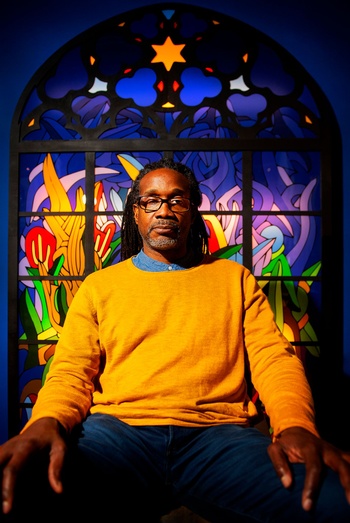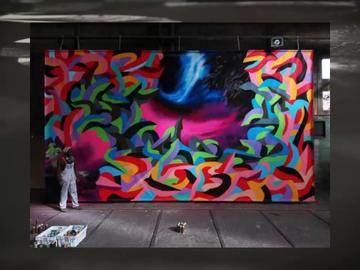With one powerful work of art, graffiti pioneer Kool Koor turns the tables on history and transforms the Halles Saint-Géry into an iconoclastic sanctuary for untold stories. “Here it is. It's on the table, either you eat it or you don't.”
© Ivan Put
“The oppressor writes the story,” Kool Koor says while elaborating on the origins of his new piece in the Halles Saint-Géry, where the exhibition “Saint-Géry: le passé présent” is nearing its end. Over the course of months, that dynamic, permanently evolving show has been delving deep into the history of the popular square and the Église Saint-Géry – founded in the tenth century, elevated to a parish church by Pope Leo X 500 years ago and finally demolished between 1798 and 1801 – in particular. A turbulent history that echoes in contemporary Brussels.
The oppressor writes the history, but here, in this powerful piece, the American-born, Brussels-based graffiti legend weaves the many narrative threads written from that surviving story back into the conversation. Not by creating a vibrant mural or canvas, but a Plexiglas installation, inspired by a stained glass window from the former Église Saint-Géry.
“I have been working on this concept called Sanctuary for quite some time,” Kool Koor says. “It's a project where I reappropriate windows from industrial sites and transform those sites into calm, solemn spaces that allow for meditation and contemplation. For years I have had the idea, but I haven't yet done a full installation. So when Anne (Wetsi Mpoma, founder of the Wetsi Art Gallery and figurehead of Brussels's art scene, Ed.) contacted me about this project and told me it was on a reproduction of a stained glass window, within the concept of iconoclasm, all the pieces fell into place.”
I wanted to bring that stained glass window to the 21st century. So I did a twist on the iconography of Saint Michael slaying the dragon, turning it to the colonial catastrophe
The artist who began to do graffiti in the South Bronx in 1976 as a 13-year-old, who along with the likes of Crash, Daze, A-One, Toxic, Futura 2000, Keith Haring and Rammellzee made the graffiti scene spill out into the gallery circuit in the early 1980s, and who, as a member of the Tag Master Killers, practised “Ikonoklast Panzerism” – “taking the letter, re-appropriating and arming it, with the goal of destroying the other letters” – immediately saw something of a link in the iconoclasm that ravaged through the Low Countries in the sixteenth century. “It's a philosophy that I have founded my career and my way of life on! I'm very diplomatic about a lot of things, but there are times when you think: 'You know what? Here it is. It's on the table, either you eat it or you don't.' This was such a moment, an opportunity to pass a message.”
THE TRUTH IS OUT
That message echoes ever stronger today. “I wanted to bring that stained glass window to the 21st century. So I did a twist on the iconography of Saint Michael slaying the dragon, turning it to the colonial catastrophe. The central figure in blue is in the same colour as the flag of the Congo, and represents the diaspora. The entity to the side, with his hands covered in blood, being squashed, is a representation of the whole system of oppression, colonialism and even religion. It's telling another version of the story, for a future where things maybe can be levelled.”

© Ivan Put
| Kool Koor in front of his Plexiglas installation: “It’s telling another version of the story, for a future where things maybe can be levelled.”
“This isn't my personal story,” Kool Koor says, “but it does touch me deeply. I adopted Belgium as my new residence long ago. Over the course of more than thirty years, I got to know its history and its complications. A lot of people here are lost in their African identity, a lot of people deny that certain things happened. When given an opportunity I thought it was my responsibility to not just do something for the sake of art, but to do something that would have substance.”
Still departing from his abstract core, this sort of labyrinthine, automatic writing and highly intoxicating mesh of organic lines and bold colours, but also opening up to a slightly more figurative approach. Up close and personal. “My very early work was figurative, you know. I can draw. But if I do that today, I would feel like I'm stepping away from myself. With stained glass you have all of these threads of lead holding everything together, and I just figured that they could be that mesh, allowing me to then tell the story through colours, to be more figurative and see it as a conversation for addressing subjects like identity, roots, history, truth.”
I see this as the time of the truth wars, of people realizing that what they have been force-fed for generations is not the whole story, that a lot of those “facts” they were taught were in fact lies
“That truth is out, you know, and it isn't going anywhere. I see this as the time of the truth wars, of people realizing that what they have been force-fed for generations is not the whole story, that a lot of those 'facts' they were taught were in fact lies. Young people nowadays have really embraced their power and position. A lot of them are fed up, they refuse to be silent and they want justice. Every generation wants justice, but this mass movement, this mass necessity to be heard and understood, is new. Times are changing. A black art gallery like Wetsi's didn't exist when I started out, though contemporary African artists have always existed, it wasn't all tingatinga art. That all makes for an opportunity to reset, to tell a different story.”
SAINT-GÉRY: LE PASSÉ PRÉSENT
> 5/3, Halles Saint-Géry, hallessaintgery.be
Read more about: Expo , Kool Koor , Halles Saint-Géry
